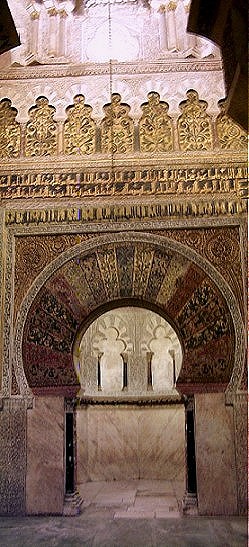
|
CORDOBACordoba is rather different from Seville, mainly in that the touristic part of the town is quite separate from the everyday Spanish part of the town. Part of the problem is that a lot of tourists seem to take coach trips to Andalousia and Cordoba tends to form a midday stopping point on the drive between Madrid and Seville. Accordingly, in the middle part of the day the area around the Mezquita is packed, for the rest of the day it is dead. The Mezquita is the ancient mosque of Cordoba and although it was converted to Christianity it is still possible to get a pretty fair idea of the original architecture. This huge building is surrounded on all sides by a hideous tourist souk, selling the worst form of cheap, tacky souvenirs. It is really a case of the sublime and the ridiculous as the Mezquita itself is a world class monument and well worth seeing. The Cordobans themselves prefer to hang out in the newer part of town, in the pedestrian area around the main shopping district. If you walk from the mosque towards the river, you soon come to a bridge resting on roman foundations with an arch on one side and an old tower on the other. The tower contains a small 'museum of the three cultures', which is a poetic, if rather idealistic monument to religious tolerance. Alongside this bridge, stretching right across the river is one of Cordoba's most interesting but underrated monuments: a group of arabic water mills. The river bed was heavily modified to flow through four channels and turn heavy wooden wheels. One, presumably a reproduction, is visible on the city side. This quite sophisticated industrial milling system was eventually shut down in Christian times, apparently because it made so much noise that the queen was unable to sleep! When I went to explore the nearly ruined mill buildings I discovered that some people were staying there. Maybe they were connected with the large flock of sheep grazing in the river bed. At this time of year the river is fairly dry and contains a good deal of vegetation. The Alcazar of Cordoba is really nothing compared to the one in Seville but it has a very pretty garden. When we went there on Friday morning we discovered that we could get in for free. The reason seemed to be that on that Fridays weddings are held in the Alcazar's chapel. The bride and groom then go and have their photographs taken in the garden. It seemed to be quite a production line as there were several wedding parties on the premises when we were there. My mother speculated that a Catholic wedding must traditionally be open to the public, and therefore the Alcazar cannot charge its usual (rather inexpensive) fee. Since Cordoba was a big centre of Arabic and Sephardic culture several restaurants are reviving the cuisine of the time. I especially liked partridge in a sauce sweetened with grapes and steamed fish in almond sauce, but my favourite was almond gazpacho served with chopped apple and sultana. Most of Spain is not really known for its desserts but I think Andalousia must be the exception as there were almost too many nice things to choose from. Cordoba's speciality is a large flat cake that tastes as though it is made of shredded turkish delight in a thin flaky pastry with lots of caster sugar. |
|
|
|
||